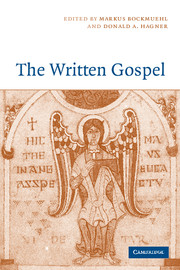Book contents
- Frontmatter
- Contents
- List of contributors
- List of abbreviations
- Introduction
- PART I BEFORE WRITING
- PART II WRITING THE FOUR GOSPELS
- PART III AFTER WRITING
- 11 The Four among Jews
- 12 The Four among pagans
- 13 Forty other gospels
- 14 The One, the Four and the many
- 15 The making of gospel commentaries
- Appendix: Graham Stanton's publications
- Bibliography
- Index of ancient sources
- Index of authors
15 - The making of gospel commentaries
Published online by Cambridge University Press: 07 December 2009
- Frontmatter
- Contents
- List of contributors
- List of abbreviations
- Introduction
- PART I BEFORE WRITING
- PART II WRITING THE FOUR GOSPELS
- PART III AFTER WRITING
- 11 The Four among Jews
- 12 The Four among pagans
- 13 Forty other gospels
- 14 The One, the Four and the many
- 15 The making of gospel commentaries
- Appendix: Graham Stanton's publications
- Bibliography
- Index of ancient sources
- Index of authors
Summary
Ours is an era saturated in commentaries. By one rough measure of counting, the world's libraries now hold over 120,000 different volumes associated with that genre. The classics of Scriptural and other ancient literature have long since been strip-mined to a point where it goes without saying that, as a famous critic wryly noted three centuries ago, ‘learned commentators view / in Homer more than Homer knew’. This is true of the gospels, as of other New Testament writings; today's commentaries, indeed, seem at times to encourage a kind of tertiary scholarship that subsists in texts about meta-texts.
But how and where did it all begin? Drowning as we are in modern biblical commentary, it may be easy to forget that there was a time before commentaries. It was the discovery of the Dead Sea Scrolls in the mid twentieth century that established an exciting and fertile new starting point of the genre in the form of several running expositions of prophetic books in eschatological terms. The history of biblical commentary thus finds a particular focus in the late second century bc, when these running expositions of the prophets first emerged, fully formed and seemingly without precedent, from the pen of monastic scribes in the Judaean wilderness.
This chapter will begin by reviewing the origins of biblical commentary against the background of ancient Graeco-Roman antecedents, before turning to the earliest commentaries on the gospels.
- Type
- Chapter
- Information
- The Written Gospel , pp. 274 - 295Publisher: Cambridge University PressPrint publication year: 2005



